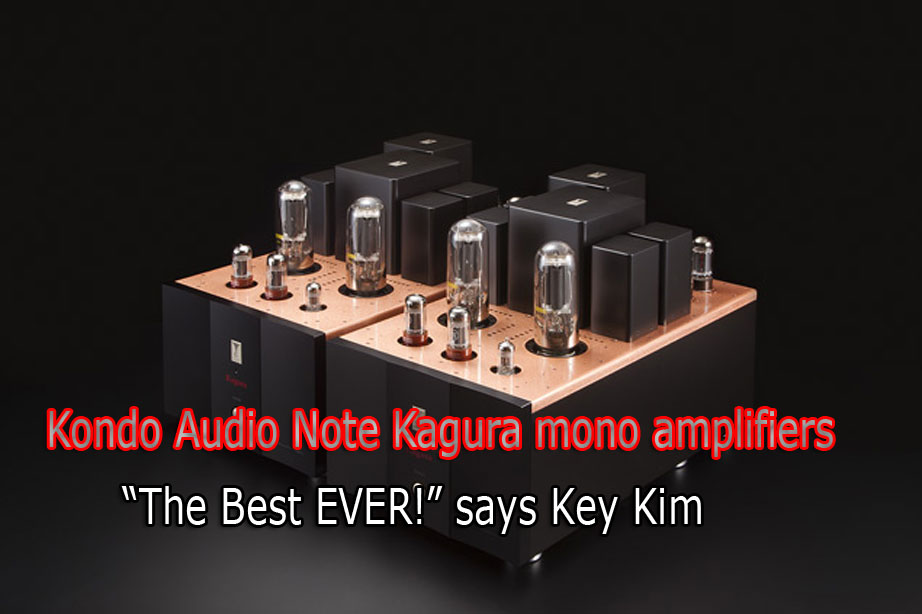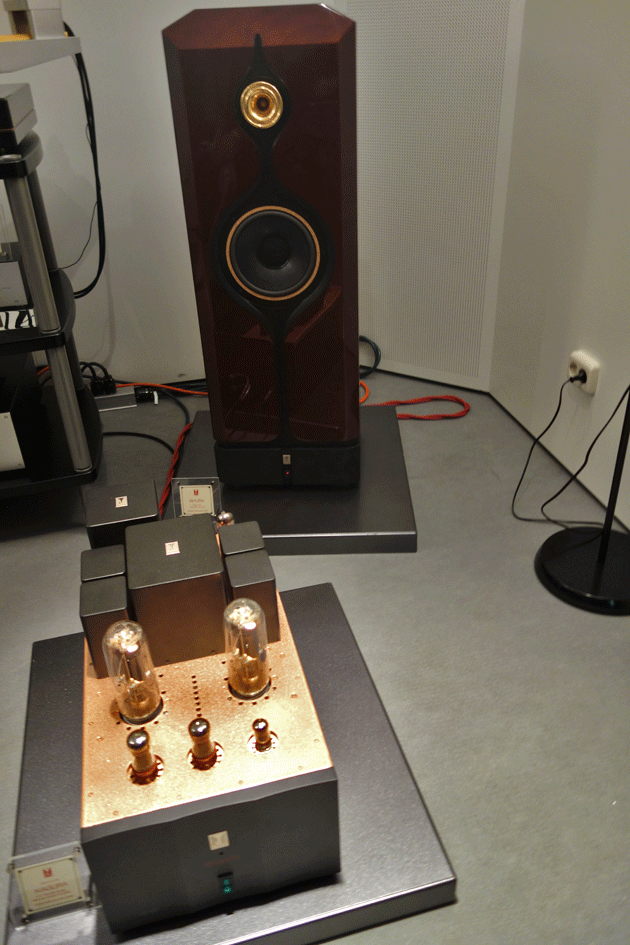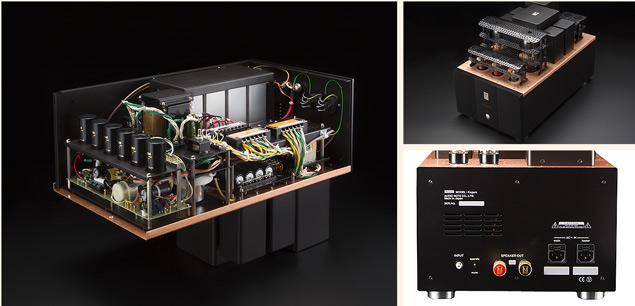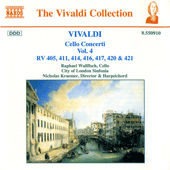Audio Note Kondo Kagura mono amplifiers

 Audio Note Kondo has a rich history in building state-of-the-art tube amplifiers that spans over three decades. Established in 1976, Hiroyasu Kondo is the founder of the Audio Note-Kondo. Driven by Kondo san’s passion for music propel him to experiment and create the best possible material to get the highest sound quality using an expensive metal which had never been used in audio design. Kondo san was the first person to use silver wires in audio designs; later he was given the name Audio Silversmith for his revolutionary use of aged annealed silver in his audio equipment. The sound of his silver is warm yet vivid and can fully express the vitality of music through its innate purity. Kondo designed and utilized the legendary handmade silver output transformers and hand wound silver foil signal capacitors in Kondo products.
Audio Note Kondo has a rich history in building state-of-the-art tube amplifiers that spans over three decades. Established in 1976, Hiroyasu Kondo is the founder of the Audio Note-Kondo. Driven by Kondo san’s passion for music propel him to experiment and create the best possible material to get the highest sound quality using an expensive metal which had never been used in audio design. Kondo san was the first person to use silver wires in audio designs; later he was given the name Audio Silversmith for his revolutionary use of aged annealed silver in his audio equipment. The sound of his silver is warm yet vivid and can fully express the vitality of music through its innate purity. Kondo designed and utilized the legendary handmade silver output transformers and hand wound silver foil signal capacitors in Kondo products.
[do not confuse products like Audio Note UK with Audio Note Kondo Japan. The two companies have no relationship whatsoever.]
The legendary Ongaku, which stands for music in Japanese, was designed by Kondo san in 1989 and instantly became a true legend. Nearly a quarter of a century later, the fanfare surrounding the Ongaku still lives on. Audio Note is known for utmost care and detail in design and execution. Though Kondo san is no longer with us, he has been ably replaced by Masaki san to take control of Audio Note Kondo here and into the future.

My first encounter with the Kagura was back at the 2013 CES. All I can remember is what a truly magical experience it was even under show conditions (consider a noisy hotel room). Still, the sound demonstrated purity in timbre, tone and delicacy that held me hostage. While enjoying a Beethoven Piano Trios disc, I knew it, right then and there, that the Audio Note Kagura’s extraordinary tonality and pitch makes it among the best products I have ever had the pleasure of listening to (in a noisy hotel room no less!). I did hear them again in Munich the following year (photo above), and again was overwhelmed by their intense sense of harmonic rightness.
The name Kagura in Japanese means Music for a Shrine or Music for the Gods. Based on the extended period of time I have been fortunate enough to spend with this incredible musical transducer, I think the name fits it just right. As I have already mentioned, my experience with the Kondo-Audio Note gear has been a most enlightening one. The sound was pure in timber, delicate in touch and utterly compelling while enjoying a Beethoven Piano Trios disc. I knew it, right then and there, the Kagura is extraordinary and is among the best products I have the pleasure of experiencing anywhere.

At the 2014 CES, Kondo-Audio Note of Japan debuted their new flagship Kagura mono-block amplifiers. I was once again taken by the unforgettable purity of the Kagura. The sound – if you can call it that – of the Kagura was so natural and intense that I said to myself “I’ve got to hear this AT HOME” (not that I could EVER afford one). I revealed my enthusiasm to CEO of Kondo-Audio Note Ashizawa Masaki-san and he referred me to Bob Visintainer of Rhapsody Music & Cinema who serves as Kondo-Audio Note’s sole US distributor here in New York City. Visintainer assured me he would arrange for a review in the near future.
Audio-Note Kondo does things a lot differently than other manufacturers when it comes to designing a new product. Most often, manufacturers introduce a new product and after a year or two they follow with a model that bears a “Mark II” type upgrade; or they come out with a different model altogether. Well Kondo is not like the others. Their current models stay in production without any upgrades or updates for several years. The idea of creating the Kagura (instead of improving on the Gakuon II) begun more than 5 years ago by Masaki. The Kagura was designed by Katsura Hirakawa (head designer) and tuned masterfully by Masaki san. The actual engineering of the Kagura started back in 2011, and after more than 2 years, the design was complete. Masaki-san found, what he described as “some weak points” in the Gakuon II when playing certain types of music which required “a very gentle, relaxed, and sweet performance.” He recognized the need to improve in these areas, with a performance similar to their 8-watt SE model called the Souga. Masaki-san decided to maintain all the positive attributes of the Gakoun II: dynamics, power, passion and soundstage, while improving on what he called its “feminine side.”
After trying various ways to improve on the sound with their current components and existing circuit design, Masaki and Katsura came to the conclusion that it would not be possible to hit their target performance unless they started everything from scratch. Masaki decided to design the Kagura from the ground up as a new statement product rather as an improved version of the Gakoun II. This design was a very challenging project; it had to be better than the already state of the art Gakuon II.
The Kagura is a parallel Single-Ended Triode pure Class-A design. It uses two 211 output tubes in parallel producing a powerful 50 watts per channel. A 12AU7 and two 6SN7 tubes are used for amplification and two 6SN7 (cathode follower) for the driver stage and four GZ34 rectifier tubes are also utilized. Already revered as the best in their class, the Kagura utilizes custom-made in-house components. As a standard, Audio Note Japan tested many different materials and components to achieve the improvements they’re known for. Masaki-san is known as master tuner: he has golden ears and knows how different materials work in each component. Masaki-san is a perfectionist, not only does he use different core materials for the transformers, he even goes as far as using different materials for transformer and choke cases.


Yes, it does take about eight weeks to build a pair of Kagura amplifiers. The Kagura only uses custom made components built in house (or out-sourced from small artisanal specialty machine shops). Kondo inspects every production step for the out-sourced components from their contractors to ensure the utmost quality. Newly designed silver foil capacitors and new transformers (choke, power transformers and output transformer) are incorporated in the Kagura. A new circuit was designed for the Kagura starting with two power cords; in their research, isolating the power supply of filaments from rest of the circuit results in an unbelievable improvement in signal-to-noise ratio. The company boasts its power supply as the heart and soul in its design (it’s a well-known fact that Audio-Note Kondo’s power supply is considered the best in the business). Both channel’s “oversized” power supply utilizes three power transformers and four choke coils. They are installed to form 3-tier, independent power supply circuit with three different voltages (+/-200V, + 450V, and +900V). The 211 heater circuit is mounted using large capacitors (40000uF x 2) to minimize ripple elements while residual noise level is kept quite low thanks to a hum balancer circuit. Brilliantly, Katsura-san uses Cut-Core transformers for the Kagura instead of the EI-core transformers normally used (except the power transformer for filaments). It is a common understanding that EI-core transformer is best for audio. Although controversial, Cut-core transformers are utilized to produce a wider and flatter frequency response than the EI-core. As expected, Katsura-san used nothing but the best Kondo legendary hand-made silver output transformers (which handle output impedances of 4, 8 and 16 Ohms.)
By selecting positions at the speaker impedance switch and changing relevant jumper plates, speaker impedance switchover is done with an NFB level always set to the designed level -3dB. To push the envelope even higher their renowned silver foil capacitor was redesigned; a new silver foil signal capacitor was designed on a core concept of further minimizing the vibration to improve the purity of the sound (lower distortion). When current flows through the capacitor, vibration is created and it causes signal contamination. To prevent this, Kondo used higher grade material for the core of the new capacitor (this material has never been used before). A new 1000V oil-filled capacitor is also an important contributor to the Kagura’s sound improvement. Instead of putting 500V + 500V capacitors in a series, this new 1000V oil capacitor lowers the impedance of the high voltage power line. This results in a much quieter background, less distortion and wider bandwidth. The internal construction of the Kagura is further optimized for the shortest signal/power paths. Components are hand wired on a module with 3D assembly; transformers and capacitors are placed just under the tubes; the input stage, driver stage and power stage are closely packed so that signal lines are truly as short as possible.
Physically, the Kagura amplifier is drop-dead gorgeous. Each chassis is massive at 137 lbs and measures 12.6” wide by 14.6” high by 22” deep. It sits on beautifully crafted aluminum footers giving the Kagura an regal appearance. Powering on the 211 tubes illuminate the unit showing off its majestic two-tone color. The Kagura is machined out of high-grade aluminum; its faceplate and back plate are made of aluminum with a black finish and the top and bottom plates are made of copper (its side panels are, copper over a black aluminum finish). The copper top plate gives it a strong appeal contrasting with the black front and side plates and an island of transformers and chokes occupy the rear real estate. The layout of the front panel is classically simple yet functional. A single round power-button at the lower center and the Kagura name above it. On the rear of the Kagura, located on its left, there is a pair of single-ended high quality custom-made RCA jack composed of silver rhodium and brass as core material. There is a mute toggle switch, and the beautifully crafted Kondo-designed copper binding posts are all silver. On the right bottom are the two IEC plugs, one for main and other for the heather. The chassis sports a well ventilated top cover and back panel as well.
Bugatti of Audio!
As I have already mentioned, my experience with the Kondo-Audio Note gear has been a most enlightening one. Sonically speaking, the Kondo gear was so good that it touched my soul with an emotion which is hard to measure. After my review, while living without the Kondo-Audio Note gear, I was in audio purgatory. However, lucky me, I was later given an opportunity to have the Kagura in my reference system in for a review.
One beautiful weekend last spring Bob Visintainer hand delivered the Kagura, the G70, along with Kondo’s silver cables. Setting up the Kagura was straightforward; all tubes and sockets were clearly labeled. I used the Kondo Silver cables and my reference Jorma Design Unity cables throughout the system. My listening was done with the G-70 as a matching preamplifier for this review. I was so impatient that I couldn’t wait until I turned it on. When I first powered up the Kagura, I was in heaven without even cueing up a song. The Kagura looked beautiful with its 211 tubes softly glowing from my listening seat. From the very first notes on the very first album, it was something extraordinary. Even without warm up time, the Kagura was superb. As a matter of fact, in my experience, the stellar sounding equipment that I reviewed didn’t really need any warm-up time at all. Don’t get me wrong, after it’s fully warmed up, it does normally sound better. But you don’t really need to wait an hour or two hours to hear its full potential. The Kagura sounds great as soon as you turn it on. It lets you enjoy the music right away by placing you in a trance.
The Kagura produced the rich harmonic palette expected from only the very best tube designs, and as a result voices appeared very dimensional and lifelike – on top of the fact – this transducer rendered the most glorious timbre, liquidity, open, and midrange purity I’ve ever heard in recorded music. The Kagura’s naturalness in rendering of timbres was as close to what I have heard in a live performance as I’ve experienced in any amplifier. Transparency and retrieval of detail are extraordinary with a sense of PRaT (pace, rhythm and timing) that is without peer. Just imagine the music, instruments, and notes magically popping out from your favorite recordings in the most wholesome and natural way you’ve ever heard. For the past few months, my experience has been truly amazing, genuinely enchanting and most humbling. The Kagura totally lacks any mechanical or artificial artifacts, instead rendering voices and instruments with a natural and organic quality.
There is more to the Kagura than unusual purity, transparency, and liquidity. The Kagura rendered large-scale symphonic works with seemingly limitless dynamic contrast along with a powerful and full bodied low-end. My reference Conspiracy loudspeakers has a nominal sensitivity rating of 92 dB and is relatively easy to drive, so they were an excellent match. The Kaguras also drove the recently reviewed Kharma DB9-S effortlessly, which has a sensitivity of 89 dB, proving the Kaguras will drive a wide range of loudspeakers without the traditional limitations of the SET design. This is no ordinary amplifier with a modest output of 50W; based on its control of the lower octaves and bottom-end extension (including dynamics). One thing’s certain, that in terms of sheer power I never got the sensation I was listening to SET. The orchestral crescendos are reproduced with great control and authority. I noticed this on Dvorak’s Symphony N0.9 in E Minor, Op.95 (London CS 6217) with maestro Fritz Reiner conducting the Chicago Symphony. The Kagura produced an enormous size and scale on a soundstage with realistic dynamic swings. From pianissimo to fortissimo, the system handled it all with great realism. Dynamic transitions were uncommonly convincing. The soundstage was phenomenal-wide, deep, and holographic, and beautifully layered with a wonderful sense of bloom and space between instrumental images. The Kagura literally removes the walls of your room. My Conspiracy loudspeakers simply disappeared. Depth was incredible and listening to classical recordings, images far back in the stage had the density and roundness of those located in the front rows. Whether listening to soloists, small ensembles, and large orchestras, all were presented with precisely the right sense of emotion, scale and space. Listening to live orchestral concerts crescendos not only got louder, they got bigger and filled my listening space completely.

I put on a beautiful recording of Vivaldi’s Cello Concerto in G. Minor, RV 416 (Naxos 8.550910) performed by Raphael Wallfisch and Andrew Watkinson conducting City of London Sinfonia. The sound was warm and captivating. The Kagura’s rendition of the cello and the string orchestra had an incredible solidity and weight, which extended all the way up the frequency band. Listening to the Kaguras, the cello’s textural and tonal clarity and physical focus were better than what I’ve heard in other amplifiers. The sonic picture possessed a substantial, undeniable physicality that was more lifelike than anything I’d heard in my system. The Kagura takes the musical experience a few steps further by imbuing images with more life and vitality.
Comparisons
The first Audio Note product to make it into my listening room was the Overture integrated amplifier (reviewed here). After that, Audio Note separates that included the Ongaku with the G70 preamplifier made their way into my humble abode. I wrote in that particular review, that I found its legendary sound truly captivating. I don’t recall having heard any design that could compete with the Ongaku’s high levels of purity and tonal accuracy. This purity, exacted out of only 27 glorious watts of Class-A power, was so stunningly good, that it was then where I realized that power only tells a fraction of the musical story behind an amplifier’s design. With the Ongaku, the music flowed with effortless type liquidity that had nothing to do with power no matter the source or genre. The Ongaku had no problem driving my Conspiracy loudspeakers at respectable volumes when necessary with an absolutely astonishing amount of finesse and purity, which I consider Kondo-Audio Note’s signature sound. Sadly after my review, while living without the Kondo-Audio Note gear, I was in audio purgatory. However, lucky me, I was later given an opportunity to have the new flagship Kagura in my reference system in for a review.
In comparison, remarkably, the Kagura does everything it does and more. Unfortunately I am basing these impressions solely on memory because the Ongaku had to go back to its US importer. Boasting 50-watts per side (almost double the power of the Ongaku), the Kagura delivered startling low-frequency performance in my listening space. It outperformed the Ongaku at delivering a deeper, tighter, and more precise bass. The double bass was definitely more alive sounding, coming through with greater control and visceral weight. The Kagura rendered large-scale symphonic works spectacularly and unlike anything I’ve heard in my space. It produced the most impressive scale and drama of a full orchestral crescendo that I’ve heard with an ease and grace that had to be heard to be believed. The soundstage was wider and deeper as well, making my front wall and side wall disappear while making my loudspeakers vanish. Of course, this created the most impressive and natural soundstage ever in my room. The Kagura’s portrayal of individual images is exemplary, revealing a better even touch than the Ongaku. The layers of small detail and nuance were eerily transparent through my Conspiracy loudspeakers when driven by the Kagura.
Conclusion
As much as I was thrilled about the Ongaku’s ability to render the human voice, and as sure as I was that it couldn’t get any better, the Kagura proved beyond compare. It offered an even more fabulous midrange, more palpable images and an awe-inspiring tonality. Music of the Gods may seem over the top to some alongside the Kagura’s bold sticker price of $150k. As I stated previously, based solely on my extended time spent with this incredible musical transducer, I couldn’t dream of anything that could outperform the Audio Note Kagura. It’s rare when a product lives up to its billing while I’ve hardly ever heard a product sound better than all the hype it has already produced. The Kagura is the only product that has done that for me thus far. In my opinion, banded with the right associated equipment, the Audio Note Kagura reigns as the supreme amplifier in the here and now.
I couldn’t believe that the Kondo-Audio Note sold ten Kaguras when they first debuted at this year’s CES. Now that I have reviewed the Kagura in my own system, I might just be the eleventh (If only I could afford one). The Kagura’s sonic consistency from top to bottom was revelatory. Listening to my music through them was poetry in motion. They produced magic with every listen, without homogenizing the faults of poor recordings. My hat’s off to Masaki-san and Katsura-san for creating a new benchmark for which all others ought to be measured against. I’m sure Hiroyasu Kondo-san would be very proud of this latest achievement. The Kagura has earned my Stereo Times 2014 “Most Wanted Components” award! In fact, it is the single most impressive product I have had the luxury of reviewing thus far. Regardless of its asking price, it’s Highy recommended! 

key kim
Specifications
Kagura Price – $150,000
Product: 211 parallel single ended monaural poweramplifier
Rated power: 50W @1kHz, 5% THD
Frequency response: 8Hz ~ 40kHz (+0dB, -3dB @1W)
Input / Impedance: 1pc (RCA, unbalanced) / 50kΩ
Output: 4, 8, 16Ω (switchable by internal jumper plates)
NoiseLess than 0.5mV
Vacuum tube: 211 x2, 6SN7 x2, 12AU7 x1, GZ34 x4
Power consumption: 270W
Dimension(excluding protrusions): 320mm(W) 370mm(H) 558mm(D)
Weight: 62kg
USA Distributor: Rhapsody Music & Cinema
Address: 27 W 24th St #506, New York. NY 10010
Phone: 212-229-1842
Website: www.rhapsodycinema.com
ecifications
Stereo Times Masthead
Publisher/Founder
Clement Perry
Editor
Dave Thomas
Senior Editors
Frank Alles, Mike Girardi, Russell Lichter, Terry London, Moreno Mitchell, Paul Szabady, Bill Wells, Mike Wright, and Stephen Yan,
Current Contributors
David Abramson, Tim Barrall, Dave Allison, Ron Cook, Lewis Dardick, John Hoffman, Dan Secula, Don Shaulis, Greg Simmons, Eric Teh, Greg Voth, Richard Willie, Ed Van Winkle, Rob Dockery, Richard Doran, and Daveed Turek
Site Management Clement Perry
Ad Designer: Martin Perry





Be the first to comment on: Audio Note Kondo Kagura mono amplifiers